The Soil Biology Primer
Chapter 7: ARTHROPODS
By Andrew R. Moldenke, Oregon State University
THE LIVING SOIL: ARTHROPODS
Many bugs, known as arthropods, make their home in the soil. They get
their name from their jointed (arthros) legs (podos). Arthropods are
invertebrates, that is, they have no backbone, and rely instead on an
external covering called an exoskeleton.
|
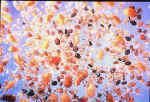
|
Figure 1: The 200 species of mites in this
microscope view were extracted from one square foot of the top two
inches of forest litter and soil. Mites are poorly studied,
but enormously significant for nutrient release in the
soil.
Credit: Val Behan-Pelletier,
Agriculture and Agri-Food Canada |
Arthropods range in size from microscopic to several inches in length.
They include insects, such as springtails, beetles, and ants; crustaceans
such as sowbugs; arachnids such as spiders and mites; myriapods, such as
centipedes and millipedes; and scorpions.
Nearly every soil is home to many different arthropod species. Certain
row-crop soils contain several dozen species of arthropods in a square
mile. Several thousand different species may live in a square mile of
forest soil.
Arthropods can be grouped as shredders, predators, herbivores, and
fungal-feeders, based on their functions in soil. Most soil-dwelling
arthropods eat fungi, worms, or other arthropods. Root-feeders and
dead-plant shredders are less abundant. As they feed, arthropods aerate
and mix the soil, regulate the population size of other soil organisms,
and shred organic material.
SHREDDERS
Many large arthropods frequently seen on the soil surface are
shredders. Shredders chew up dead plant matter as they eat bacteria and
fungi on the surface of the plant matter. The most abundant shredders are
millipedes and sowbugs, as well as termites, certain mites, and roaches.
In agricultural soils, shredders can become pests by feeding on live roots
if sufficient dead plant material is not present.
|
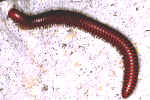
|
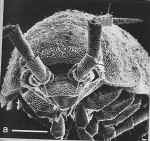
|
Figure 3: Millipedes are also called
Diplopods because they possess two pairs of legs on each body
segment. They are generally harmless to people, but most millipedes
protect themselves from predators by spraying an offensive odor from
their skunk glands. This desert-dwelling giant millipede is about 8
inches long.
Orthoporus
ornatus.
Credit: David B.
Richman, New Mexico State University, Las Cruces. |
Figure 4: Sowbugs are relatives of crabs
and lobsters. Their powerful mouth-parts are used to fragment plant
residue and leaf litter.
Credit: Gerhard
Eisenbeis and Wilfried Wichard. 1987. Atlas on the Biology of
Soil Arthropods. Springer-Verlag, New York. P.
111. |
PREDATORS
Predators and micropredators can be either generalists, feeding on many
different prey types, or specialists, hunting only a single prey type.
Predators include centipedes, spiders, ground-beetles, scorpions,
skunk-spiders, pseudoscorpions, ants, and some mites. Many predators eat
crop pests, and some, such as beetles and parasitic wasps, have been
developed for use as commercial biocontrols.
|

|
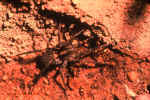
|
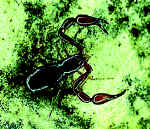
|
Figure 7: This 1/8 of an inch long spider
lives near the soil surface where it attacks other soil arthropods.
The spider's eyes are on the tip of the projection above its
head.
Walckenaera acuminata.
Credit:
Gerhard Eisenbeis and Wilfried Wichard. 1987. Atlas on
the Biology of Soil Arthropods. Springer-Verlag, New York. P.
23. |
Figure 8: The wolf-spider wanders around
as a solitary hunter. The mother wolf-spider carries her young to
water and feeds them by regurgitation until they are ready to hunt
on their own.
Credit: Trygve Steen,
Portland State University, Portland, Oregon. |
Figure 9: The pseudoscorpion looks like a
baby scorpion, except it has no tail. It produces venom from
glandsin its claws and silk from its mouth parts. It lives in the
soil and leaf litter of grasslands, forests, deserts and croplands.
Some hitchhike under the wings of beetles.
Credit:
David B. Richman, New Mexico State University, Las
Cruces |
|

|
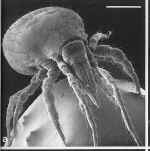
|
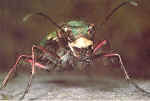 |
Figure 10: Long, slim centipedes crawl
through spaces in the soil preying on earthworms and other
soft-skinned animals. Centipede species with longer legs are
familiar around homes and in leaf
litter.
Credit: No. 40 from
Soil Microbiology and Biochemistry Slide Set. 1976. J.P.
Martin, et al., eds. SSSA, Madison, WI |
Figure 11: Predatory mites prey on
nematodes, springtails, other mites, and the larvae of insects. This
mite is 1/25 of an inch (1mm) long.
Pergamasus
sp.
Credit: Gerhard Eisenbeis and
Wilfried Wichard. 1987. Atlas on the Biology of Soil
Arthropods. Springer-Verlag, New York. P. 83. |
Figure 12: The powerful mouthparts on the
tiger beetle (a carabid beetle) make it a swift and deadly
ground-surface predator. Many species of carabid beetles are common
in cropland.
Credit: Cicindlla
campestris. D.I. McEwan/Aguila Wildlife Images |
|
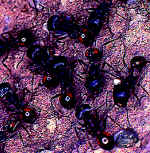
|
|
|
Figure 13: Rugose harvester ants are
scavengers rather than predators. They eat dead insects and gather
seeds in grasslands and deserts where they burrow 10 feet into the
ground. Their sting is 100 times more powerful than a fire ant
sting.
Pogonomyrmex rugosus
Credit: David
B. Richman, New Mexico State University, Las Cruces. |
|
|
HERBIVORES
Numerous root-feeding insects, such as cicadas, mole-crickets, and
anthomyiid flies (root-maggots), live part of all of their life in the
soil. Some herbivores, including rootworms and symphylans, can be crop
pests where they occur in large numbers, feeding on roots or other plant
parts.
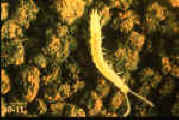 |
Figure 14: The symphylan, a relative of
the centipede, feeds on plant roots and can become a major crop pest
if its population is not controlled by other
organisms.
Credit: Ken Gray Collection,
Department of Entomology, Oregon State University,
Corvallis. |
FUNGAL FEEDERS
Arthropods that graze on fungi (and to some extent bacteria) include
most springtails, some mites, and silverfish. They scrape and consume
bacteria and fungi off root surfaces. A large fraction of the nutrients
available to plants is a result of microbial-grazing and nutrient release
by fauna.
|

|
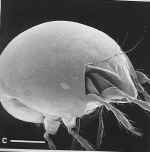
|
Figure 17: This pale-colored and blind
springtail is typical of fungal-feeding springtails that live deep
in the surface layer of natural and agricultural soils throughout
the world.
Credit: Andrew R. Moldenke,
Oregon State University, Corvallis |
Figure 18: Oribatid turtle-mites are
among the most numerous of the micro-arthropods. This
millimeter-long species feeds on fungi.
Euzetes
globulus
Credit: Gerhard Eisenbeis and
Wilfried Wichard. 1987. Atlas on the Biology of Soil
Arthropods. Springer-Verlag, New York. P.
103 |
WHAT IS IN YOUR SOIL?
If you would like to see what kind of organisms are in your soil, you
can easily make a pitfall trap to catch large arthropods, and a Burlese
funnel to catch small arthropods.
Make a pitfall trap by sinking a pint- or quart-sized container (such
as a yogurt cup) into the ground so the rim is level with the soil
surface. If desired, fashion a roof over the cup to keep the rain out, and
add 1/2 of an inch of non-hazardous antifreeze to the cup to preserve the
creatures and prevent them from eating one another. Leave in place for a
week and wait for soil organisms to fall into the trap.
To make a Burlese funnel, set a piece of 1/4 inch rigid wire screen in
the bottom of a funnel to support the soil. (A funnel can be made by
cutting the bottom off a plastic soda bottle.) Half fill the funnel with
soil, and suspend it over a cup with a bit of anti-freeze or ethyl alcohol
in the bottom as a preservative.
Suspend a light bulb about 4 inches over the soil to drive the
organisms out of the soil and into the cup. Leave the light bulb on for
about 3 days to dry out the soil. Then pour the alcohol into a shallow
dish and use a magnifying glass to examine the organisms.
WHAT DO ARTHROPODS DO?
Although the plant feeders can become pests, most arthropods perform
beneficial functions in the soil-plant system.
Shred organic material. Arthropods increase the
surface area accessible to microbial attack by shredding dead plant
residue and burrowing into coarse woody debris. Without shredders, a
bacterium in leaf litter would be like a person in a pantry without a
can-opener – eating would be a very slow process. The shredders act like
can-openers and greatly increase the rate of decomposition. Arthropods
ingest decaying plant material to eat the bacteria and fungi on the
surface of the organic material.
Stimulate microbial activity. As arthropods graze on
bacteria and fungi, they stimulate the growth of mycorrhizae and other
fungi, and the decomposition of organic matter. If grazer populations get
too dense the opposite effect can occur – populations of bacteria and
fungi will decline. Predatory arthropods are important to keep grazer
populations under control and to prevent them from over-grazing
microbes.
Mix microbes with their food. From a bacterium’s
point-of-view, just a fraction of a millimeter is infinitely far away.
Bacteria have limited mobility in soil and a competitor is likely to be
closer to a nutrient treasure. Arthropods help out by distributing
nutrients through the soil, and by carrying bacteria on their exoskeleton
and through their digestive system. By more thoroughly mixing microbes
with their food, arthropods enhance organic matter decomposition.
Mineralize plant nutrients. As they graze, arthropods
mineralize some of the nutrients in bacteria and fungi, and excrete
nutrients in plant-available forms.
Enhance soil aggregation. In most forested and
grassland soils, every particle in the upper several inches of soil has
been through the gut of numerous soil fauna. Each time soil passes through
another arthropod or earthworm, it is thoroughly mixed with organic matter
and mucus and deposited as fecal pellets. Fecal pellets are a highly
concentrated nutrient resource, and are a mixture of the organic and
inorganic substances required for growth of bacteria and fungi. In many
soils, aggregates between 1/10,000 and 1/10 of an inch (0.0025mm and
2.5mm) are actually fecal pellets.
Burrow. Relatively few arthropod species burrow
through the soil. Yet, within any soil community, burrowing arthropods and
earthworms exert an enormous influence on the composition of the total
fauna by shaping habitat. Burrowing changes the physical properties of
soil, including porosity, water-infiltration rate, and bulk density.
Stimulate the succession of species. A dizzying array
of natural bio-organic chemicals permeates the soil. Complete digestion of
these chemicals requires a series of many types of bacteria, fungi, and
other organisms with different enzymes. At any time, only a small subset
of species is metabolically active – only those capable of using the
resources currently available. Soil arthropods consume the dominant
organisms and permit other species to move in and take their place, thus
facilitating the progressive breakdown of soil organic matter.
Control pests. Some arthropods can be damaging to crop
yields, but many others that are present in all soils eat or compete with
various root- and foliage-feeders. Some (the specialists) feed on only a
single type of prey species. Other arthropods (the generalists), such as
many species of centipedes, spiders, ground-beetles, rove-beetles, and
gamasid mites, feed on a broad range of prey. Where a healthy population
of generalist predators is present, they will be available to deal with a
variety of pest outbreaks. A population of predators can only be
maintained between pest outbreaks if there is a constant source of
non-pest prey to eat. That is, there must be a healthy and diverse food
web.
A fundamental dilemma in pest control is that tillage and insecticide
application have enormous effects on non- target species in the food web.
Intense land use (especially monoculture, tillage, and pesticides)
depletes soil diversity. As total soil diversity declines, predator
populations drop sharply and the possibility for subsequent pest outbreaks
increases.
WHERE DO ARTHROPODS LIVE?
The abundance and diversity of soil fauna diminishes significantly with
soil depth. The great majority of all soil species are confined to the top
three inches. Most of these creatures have limited mobility, and are
probably capable of “cryptobiosis,” a state of “suspended animation” that
helps them survive extremes of temperature, wetness, or dryness that would
otherwise be lethal.
As a general rule, larger species are active on the soil surface,
seeking temporary refuge under vegetation, plant residue, wood, or rocks.
Many of these arthropods commute daily to forage within herbaceous
vegetation above, or even high in the canopy of trees. (For instance, one
of these tree-climbers is the caterpillar-searcher used by foresters to
control gypsy moth). Some large species capable of true burrowing live
within the deeper layers of the soil.
Below about two inches in the soil, fauna are generally small – 1/250
to 1/10 of an inch. (Twenty-five of the smallest of these would fit in a
period on this page.) These species are usually blind and lack prominent
coloration. They are capable of squeezing through minute pore spaces and
along root channels. Sub-surface soil dwellers are associated primarily
with the rhizosphere (the soil volume immediately adjacent to roots).
ABUNDANCE OF ARTHROPODS
A single square yard of soil will contain 500 to 200,000 individual
arthropods, depending upon the soil type, plant community, and management
system. Despite these large numbers, the biomass of arthropods in soil is
far less than that of protozoa and nematodes.
In most environments, the most abundant soil dwellers are springtails
and mites, though ants and termites predominate in certain situations,
especially in desert and tropical soils. The largest number of arthropods
are in natural plant communities with few earthworms (such as conifer
forests). Natural communities with numerous earthworms (such as grassland
soils) have the fewest arthropods. Apparently, earthworms out-compete
arthropods, perhaps by excessively reworking their habitat or eating them
incidentally. However, within pastures and farm lands arthropod numbers
and diversity are generally thought to increase as earthworm populations
rise. Burrowing earthworms probably create habitat space for arthropods in
agricultural soils.
BUG BIOGRAPHY: Springtails
 Springtails are the most abundant arthropods in
many agricultural and rangeland soils. populations of tens of thousands
per square yard are frequent. When foraging, springtails walk with 3 pairs
of legs like most insects, and hold their tail tightly tucked under the
belly. If attacked by a predator, body fluid rushes into the tail base,
forcing the tail to slam down and catapult the springtail as much as a
yard away. Springtails have been shown to be beneficial to crop plants by
releasing nutrients and by feeding upon diseases caused by
fungi. Springtails are the most abundant arthropods in
many agricultural and rangeland soils. populations of tens of thousands
per square yard are frequent. When foraging, springtails walk with 3 pairs
of legs like most insects, and hold their tail tightly tucked under the
belly. If attacked by a predator, body fluid rushes into the tail base,
forcing the tail to slam down and catapult the springtail as much as a
yard away. Springtails have been shown to be beneficial to crop plants by
releasing nutrients and by feeding upon diseases caused by
fungi.
Next
chapter: Earthworms ->
<Return
to the Soil Biology Primer home page
Back To Lychee Info
|

